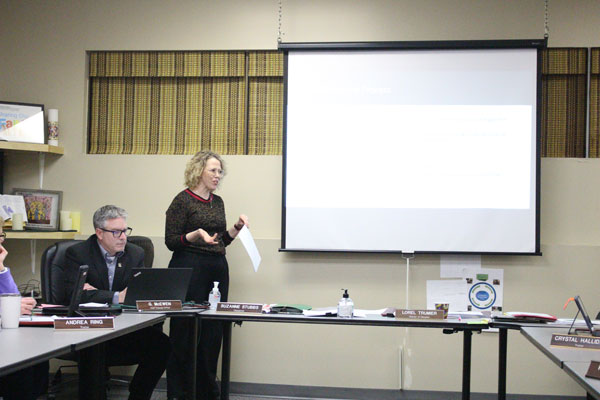
How the Prince Albert Catholic School Division responds to students in need was the focus of a presentation to the board of education during their regular meeting on Monday, Jan. 23.
Peggy Telfer, coordinator of student services and superintendent Charity Dmytruk presented on the Student Support Services HUB model and outlined the work the division does with the HUB.
HUB is a proactive multi-agency inter-ministerial team designed to mobilize services to an individual or their families.
“I think you heard the word proactive 50 times in the presentation, and I think it’s really important that that’s the role of the hub, and we’re grateful for the partnerships with the different organizations to really be proactive, to help people who are perhaps requiring some assistance,” director of education Lorel Trumier said.
The hub provides immediate, coordinated response to mitigate the elevated risk to reduce harm, crime and victimization. Trumier said the goal is to help students who need support for things happening outside of school.
“There might be something going on in their lives where they need that extra support, and we do know as a school division that sometimes that impacts the children in the family or it’s the child themselves that may be requiring more assistance beyond what we’re able to provide,” she explained.
Meetings take place at the Prince Albert Police Service downtown substation each week. Connections to those in need of service typically occur Thursday afternoon.
Partners included both school divisions, PAPS, RCMP, the Ministry of Social Services (Child Protection Unit) and Mobile Crisis.
“It just shows that this proactive approach can really support people who may require some additional assistance where that inter-collaboration between ministries is so valuable,” Trumier said.
Administrators make HUB referrals when the issues facing students go beyond the scope of the school and there are several risk factors indicate the probability of some type of harm occurring.
Trumier explained that when Telfer was asked if the support offered is turned down that it is a rare occurrence.
The HUB idea was brought in by former Prince Albert police chief Dale McFee. Trumier said it has been around for her entire 12 years as director.
“Dale McFee was seeking the support of organizations such as the school Divisions and Health Authority at the time, um, the social services, those kinds of organizations to see if we could do something proactive,” she explained.
HUB is for students and families who are not connected to services but are facing risks of harm. A referral can also be made for families that have multi-agency needs that have not been addressed.
The first step in the HUB referral process is that staff and administration exhaust all services and connections to help mitigate the risk. The second step sees the superintendent or designate informed that a referral is being made.
Assistance is provided to administration in filling out the referral. The referral is stored in a secure location and presented at the next HUB meeting. After the meeting the administration is called to discuss the outcome and whether connections were made.
HUB has a four filer process in the meeting. The first filter is presentation without names or identification to the table. It is assigned a case number and if the table agrees it moves to the next filter.
In filter two, the names and information is shared. In the third filter information and additional knowledge is shared about the families and then solutions are brainstormed. The fourth filter involves a discuss by the relevant agencies following the regular HUB meeting.
She said that it supports needs in the community before they can cost more in later stages.
“It becomes much more complex and much more difficult to be able to support at a later stage,” Trumier said. “Really, it was in the spirit of helping others that this had come to be and we’ve been pioneering that.
“We pioneered it in this province and it was expanded across the province. I believe that we’ve had such good support from our stakeholders at the table with all the ministries there that everyone has seen value. Otherwise it would not have been sustained over the last 12 years,” she explained.
There are currently 14 HUB Tables active in the province including Prince Albert, Meadow Lake, Yorkton, Nipawin, La Ronge, Weyburn and others.
The Hub Model is also known as the Community Mobilization Prince Albert approach and Situation Tables in other jurisdictions.
The response to each referral is unique based on the case. Most connections are made with a door knock visit though some are handled through phone calls. The originating agency of the referral is never revealed to the family.
Connections and supports are offered to families including referrals to agencies including the Food Bank, Mental Health, Catholic Family Services and the Women’s Shelter. Files are not case managed and the goal is to provide support to families the day the referral is presented. The intent is to connect the family to services and close the new files as soon as possible.
Telfer acts as the representative at the HUB table and rarely misses meetings and when she does sends a substitute
“I think that the good work that’s happening in schools, and with Peggy and Charity, has been really important to the endeavour,” Trumier said. “We’re always growing and learning from this and supporting others is what we need to do.”
michael.oleksyn@paherald.sk.ca

